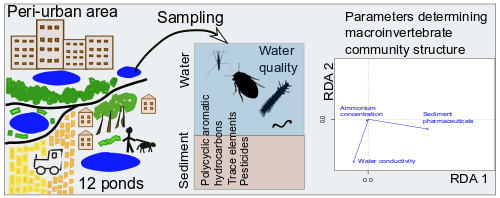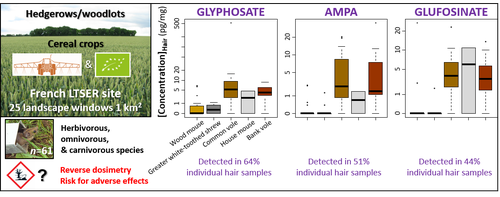
LABADIE Pierre
- UMR 5805 EPOC, CNRS, Bordeaux, France
- Analytical Chemistry, Bioaccumulation/biomagnification, Biotransformation, Environmental chemistry, Environmental monitoring, Environmental pollution, Environmental risk assessment, Legacy and emerging contaminants, Sources and Fate
- recommender, manager, administrator
Recommendations: 4
Reviews: 0
Recommendations: 4

Do macroinvertebrate abundance and community structure depend on the quality of ponds located in peri-urban areas?
Integrating chemical and biological assessments to understand the impact of pollutants on freshwater biodiversity in model systems such as peri-urban ponds
Recommended by Pierre Labadie based on reviews by Aurélie GOUTTE and 2 anonymous reviewersPonds, as small freshwater ecosystems, are particularly vulnerable due to their limited size. Yet they are often overlooked in research, possibly because they are considered less important (Biggs et al., 2017). Shallow water bodies support higher biodiversity than larger aquatic ecosystems. Peri-urban areas, characterized by a blend of agricultural and urban land uses, are dynamic and constantly evolving landscapes with diverse activities and stakeholders (Zoomers et al., 2017); as such, they are referred to as "restless landscapes" or zones of continual transformation (Zoomers et al., 2017). They often harbor neglected ecosystems, and despite their ecological importance, ponds and wetlands in peri-urban areas remain relatively underexplored (Wanek et al., 2021). Furthermore, these areas may experience increased contaminant inputs, which are regarded as one of the 12 major threats to freshwater biodiversity (Reid et al., 2019).
In this context, Hulot et al. (2025) monitored 12 peri-urban ponds in the Île-de-France region (near Paris, France) to investigate the relationships between land use, pollutant concentrations in water and sediment, and macroinvertebrate distribution. The originality of this work lies in its multidisciplinary and integrated approach, combining ecological and chemical analyses. While assessing agricultural, urban, grassland, and forest landscapes surrounding each pond, this study aimed to understand how contaminants constrain macroinvertebrate communities. The authors hypothesized that i) ponds in grassland and forest environments support higher local diversity than those in agricultural or urban areas, ii) rare and pollution-sensitive species significantly contribute to regional diversity, and iii) contaminants in water and sediment influence the distribution of macroinvertebrate morphotaxa.
This study provides numerous novel results. Specifically, it demonstrates that fluctuations in morphotaxa composition are predominantly driven by species replacement rather than by disparities in species richness. This pattern was largely attributed to the high prevalence of pollutant-tolerant species in certain ponds. In addition, community compositions appeared to be influenced by sediment levels of pharmaceuticals, water conductivity, and ammonium concentrations. In summary, ponds located in peri-urban areas are subject to a range of human-induced disturbances, and these results suggest that these disturbances lead to chronic and varied contamination, which in turn affects the composition of morphotaxa communities.
These findings establish a clear connection between local pollution and ecological composition, a crucial aspect for effective conservation and restoration efforts on peri-urban ponds.
References
Biggs, J., S. von Fumetti, Kelly-Quinn M. (2017). The importance of small waterbodies for biodiversity and ecosystem services: implications for policy makers. Hydrobiologia 793(1): 3-39 625. https://doi.org/10.1007/s10750-016-3007-0
Hulot, F.D., Hanot, C., Nélieu, S., Lamy, I., Karolak, S., Delarue, G., Baudry E., (2024) Do macroinvertebrate abundance and community structure depend on the quality of ponds located in peri-urban areas? ver.3 peer-reviewed and recommended by PCI Ecotoxicology and Environmental Chemistry. https://hal.science/hal-04850220v1
Reid, A. J., A. K. Carlson, I. F. Creed, E. J. Eliason, P. A. Gell, P. T. J. Johnson, 712 K. A. Kidd, T. J. MacCormack, J. D. Olden, S. J. Ormerod, J. P. Smol, W. W. Taylor, K. Tockner, J. C. Vermaire, D. Dudgeon, Cooke, S. J. 2019. Emerging threats and persistent conservation challenges for freshwater biodiversity. Biological Reviews 94(3):849-873. https://doi.org/10.1111/brv.12480
Wanek, A., C. L. M. Hargiss, J. Norland, Ellingson, N. 2021. Assessment of water quality in ponds across the rural, peri-urban, and urban gradient. Environmental Monitoring and Assessment 193: 694. https://doi.org/10.1007/s10661-021-09471-7
Zoomers, A., F. van Noorloos, K. Otsuki, G. Steel, van Westen, G. 2017. The Rush for Land in anUrbanizing World: From Land Grabbing Toward Developing Safe, Resilient, and Sustainable Cities and Landscapes. World Dev 92:242-252. https://doi.org/10.1016/j.worlddev.2016.11.016

Exposure of wild mammals to glyphosate, AMPA, and glufosinate: a case for “emerging organic contaminants”?
The widespread detection of glyphosate, AMPA, and glufosinate in rodents and shrews from French agricultural landscapes underscores significant concerns about their potential toxicological impacts in non-target organisms
Recommended by Pierre Labadie based on reviews by Sabrina Tartu and 3 anonymous reviewersPesticides give rise to considerable concern due to their impact on biodiversity. Amongst the vast range of compounds used as herbicides, glyphosate (GLY) is the most widely applied one at global scale and its transformation product, aminomethylphosphonic acid (AMPA) is also ubiquitous. However, the toxicity of these chemicals on non-target organisms, including mammals, is somewhat overlooked (Kissane et al., 2017). Beside these two chemicals, Fritsch et al. (2024) also considered another organophosphorus herbicide, i.e. glufosinate (GLUF). Their study examined exposure levels in rodents and shrews living in contrasted cropped and semi-natural habitats in France – i.e., conventional farmland, organic fields, and hedgerows – through the analysis of herbicide residues in their hair. The hypothesis that herbicide residues in hair reflect the exposure to multiple pesticides in wildlife is supported by several papers (i.e. Krief et al. 2017; Fritsch et al. 2022).
Results obtained by Fritsch et al. (2024) indicated that the target compounds were widespread in the investigated environments, i.e. GLY, AMPA, and GLUF were detected in 64%, 51%, and 44% of samples, respectively. Diet appeared as a major driver of contamination, as herbivorous and omnivorous voles exhibited higher contamination levels than insectivorous or omnivorous species such as shrews and wild mice. In addition, habitat was also a significant factor: GLY concentrations were particularly high in individuals collected from hedgerows, surpassing those found in crop fields. This unexpected result highlights the contamination of areas considered as ecological refuges for the investigated species. Exposure levels did not show clear differences across sites, based on farming practices or pesticide application intensity.
In addition, the measured concentrations of GLY (median 2.7 pg/mg), AMPA (median 1.4 pg/mg), and GLUF (median 3.5 pg/mg) frequently reached thresholds associated with toxic effects on small mammals. In worst case scenarios, exceedance percentages attained values as high as 94 %.
Altogether, these results definitely raise concerns about the potential impact of GLY, AMPA and GLUF on non-target wildlife species and populations. These findings by Fritsch et al. (2024) therefore emphasize the widespread presence of these chemicals in agricultural landscapes and question the safety of herbicide use, even in habitats meant to protect biodiversity. This study underscores the need for more comprehensive evaluation of the ecological effects of herbicides to guide policy and conservation efforts.
References
Kissane Z, Shephard JM (2017) The rise of glyphosate and new opportunities for biosentinel early-1068 warning studies. Conservation Biology 31: 1293–1300; https://doi.org/10.1111/cobi.12955
Krief S, Berny P, Gumisiriza F, Gross R, Demeneix B, Fini JB, et al. (2017) Agricultural expansion as risk to endangered wildlife: Pesticide exposure in wild chimpanzees and baboons displaying facial dysplasia. Science of the Total Environment 598:647–656; 1072; https://doi.org/10.1016/j.scitotenv.2017.04.113
Fritsch C, Appenzeller BM, Burkart L, Coeurdassier M, Scheifler R, Raoul F, et al. (2022) Pervasive exposure 1041 of wild small mammals to legacy and currently used pesticide mixtures in arable landscapes. 1042 Sci Rep 12:15904; https://doi.org/10.1038/s41598-022-19959-y
Fritsch C, Appenzeller BM, Bertrand C, Coeurdassier M, Driget V, Hardy EM, Palazzi P, et al. (2024) Exposure of wild mammals to glyphosate, AMPA, and glufosinate: a case for “emerging organic contaminants”?. HAL, ver.3 peer-reviewed and recommended by PCI Ecotoxicology and Environmental Chemistry https://hal.science/hal-04485797
Identifying pesticide mixtures at country-wide scale
An original approach for the identification of relevant pesticides mixtures at nationwide scale
Recommended by Pierre Labadie based on reviews by Patrice Couture and Clémentine FRITSCHOver the last decades, pesticides have been massively used in agriculture and their impacts on both the environment and human health are a major growing concern (Humann-Guilleminot et al., 2019; 2019 Boedeker et al., 2020). Improving the prediction of wildlife exposure to pesticides and the associated impacts on ecosystems is therefore crucial. In general, ecotoxicological studies addressing the effects of pesticides include compounds that are selected based on general use over large areas (e.g. regions, country) or specific crop types. Such a selection does not necessarily reflect the mixtures to which species of wildlife are exposed in a particular ecosystem.
In this context, Cairo et al. (2023) present an original approach to identify relevant mixtures of current-use pesticides. Their approach relies on public data concerning pesticide sales and cropping, available at a nationwide scale in France and at a relatively high resolution (i.e. postcode of the buyer). Based on a number of clearly exposed and discussed assumptions (e.g. “pesticides were used in the year of purchase and in the postcode of purchase”), their approach allowed for identifying 18 groups that were discriminated by a reduced number of pesticides. Some compounds were found in most or all groups and were termed “core substances” (e.g. deltamethrin and lambda-cyhalothrin). Other compounds, however, were associated with a limited number of groups and termed “discriminant substances” (e.g. boscalid and epoxiconazole).
The authors identified groups of molecules that are probably associated with the same mixtures, which warrants the investigation of potential synergetic effects. In addition, their approach allowed for the identification of areas where aquatic biota may be exposed to similar mixtures, which is might prove of interest to further investigate in situ the actual impacts of pesticide mixtures on ecosystems. Note that the approach taken by the authors might be applied by others in other countries, provided a database of pesticide sales is available.
REFERENCES
Boedeker W, Watts M, Clausing P, Marquez E (2020) The global distribution of acute unintentional pesticide poisoning: estimations based on a systematic review. BMC Public Health, 20, 1875. https://doi.org/10.1186/s12889-020-09939-0
Cairo M, Monnet A-C, Robin S, Porcher E, Fontaine C (2023) Identifying pesticide mixtures at country-wide scale. HAL, ver. 2 peer-reviewed and recommended by Peer Community in Ecotoxicology and Environmental Chemistry. https://hal.science/hal-03815557
Humann-Guilleminot S, Tassin de Montaigu C, Sire J, Grünig S, Gning O, Glauser G, Vallat A, Helfenstein F (2019) A sublethal dose of the neonicotinoid insecticide acetamiprid reduces sperm density in a songbird. Environmental Research, 177, 108589. https://doi.org/10.1016/j.envres.2019.108589

Soot and charcoal as reservoirs of extracellular DNA
New insights into eDNA sorption onto environmental carbonaceous materials
Recommended by Pierre Labadie based on reviews by Jérôme Duval and 1 anonymous reviewerIn recent years, the use of environmental DNA (eDNA) to investigate biodiversity has gained considerable interest (Thomsen and Willerslev, 2015; Mauvisseau et al., 2022). It allows for the indirect detection of species but it requires a sound understanding of eDNA behaviour and persistence in the environment. This is, however, a complex task because eDNA may be found in several states (e.g., dissolved, adsorbed, intracellular or intraorganellar), which display specific decay rates controlled by environmental factors (Harrisson et al., 2019; Mauvisseau et al. 2022). In the environment, dissolved DNA may interact with the surfaces of various sorbents, including mineral and organic particles/colloids. Current knowledge on eDNA sorption suggests that eDNA–sorbent interactions are controlled by electrostatics as well as inner-sphere complex formation (Mauvisseau et al., 2022).
In this context, the work undertaken by Jelavic et al. (2022), focused on the adsorption of eDNA by lesser-investigated carbonaceous materials (CMs), namely soot and charcoal, as common non-mineral environmental surfaces.
The authors aimed to study the adsorption capacity of soot and charcoal surfaces with respect to eDNA, in relation to solution parameters (i.e., pH, ionic strength, concentration/type of cations), time and eDNA length, under both non‐equilibrium and equilibrium conditions. Using such an approach, Jelavic et al. demonstrated the large adsorption capacities of CMs and the strong binding of DNA to these sorbents. The authors did not provide definitive conclusions on the mechanisms of eDNA sorption onto CMs. However, they provided new elements suggesting that, along with electrostatic interactions, hydrophobic interactions might play an important role in the adsorption of eDNA to CMs such as soot and charcoal.
Altogether, the results presented in this paper highlight the relevance of CMs as sources of biodiversity information. In addition, it is likely that those results will also prove useful for the community to improve protocols for eDNA extraction from environmental samples that contain high fractions of CMs, e.g. urban soils.
References
Harrison JB, Sunday JM, Rogers SM (2019) Predicting the fate of eDNA in the environment and implications for studying biodiversity. Proceedings of the Royal Society B: Biological Sciences, 286, 20191409. https://doi.org/10.1098/rspb.2019.1409
Jelavic S, Thygesen LG, Magnin V, Findling N, Müller S, Meklesh V, Sand KK (2022) Soot and charcoal as reservoirs of extracellular DNA. ChemRxiv, ver. 5 peer-reviewed and recommended by Peer Community in Ecotoxicology and Environmental Chemistry. https://doi.org/10.26434/chemrxiv-2021-9pz8c-v5
Mauvisseau Q, Harper LR, Sander M, Hanner RH, Kleyer H, Deiner K (2022) The Multiple States of Environmental DNA and What Is Known about Their Persistence in Aquatic Environments. Environmental Science & Technology, 56, 5322–5333. https://doi.org/10.1021/acs.est.1c07638
Thomsen PF, Willerslev E (2015) Environmental DNA – An emerging tool in conservation for monitoring past and present biodiversity. Biological Conservation, 183, 4–18. https://doi.org/10.1016/j.biocon.2014.11.019